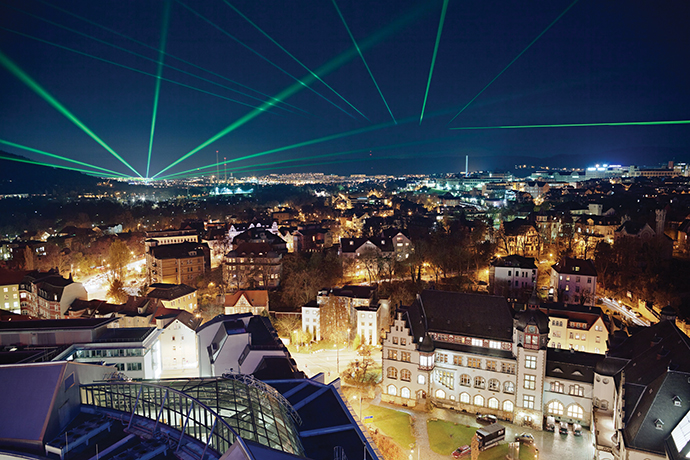When a situation has good optics, we know a good, positive image is being projected to the world at large.
In Germany’s state of Thuringia, it means an optics and photonics industry sector with arguably the best global image of any cluster in this highly embedded field of endeavor. With the sector’s sensors, metrology and other innovations now part of so many industries and technologies — from autonomous driving to industrial processes to med-tech, digitization and Industry 4.0 — it means the overall optics for Thuringia are very, very good.
“There are few places on the planet as fertile for photonics — or where the field is as historically embedded — as Thuringia,” says Peter Hallett, director of marketing and industry relations for SPIE, the international society for optics and photonics based in Bellingham, Washington.
The vision for the area’s future begins with its location, bordered by Saxony, Saxony-Anhalt, Lower Saxony, Hesse and Bavaria, and at the virtual center of a powerful European region in both consumer and industry terms.
“We are the most western part of eastern Germany,” says Dr. Arnulf Wulff, senior vice president of Investment, International Business and Cluster Promotion for the State Development Corporation of Thuringia (LEG), “and that is a strong advantage for us. We are very, very central. It is a unique situation worldwide — you have this circle of territory within an 800-kilometer [500-mile] radius with 80 percent of the manufacturing in all of Europe.” Moreover, it can be accessed without customs and border waits. “That is a very high concentration of economic power in a relatively small area,” says Wulff. “Compare it to the US, which has 330 million people, whereas we have 280 million in this relatively small circle.”
A Cluster Without Peer
Imagine focusing in on that circle with the precision of a microscope made in Jena, otherwise known as Optical Valley.
“Unlike innovation hubs in China, such as Shenzhen or Wuhan, or technical centers in the USA, including California, New York, Arizona, Florida, and Colorado, the infrastructure in Jena and in Thuringia generally is established, the top-quality workforce exists, and trusted collaborators extend across regional and international borders,” says Hallett.
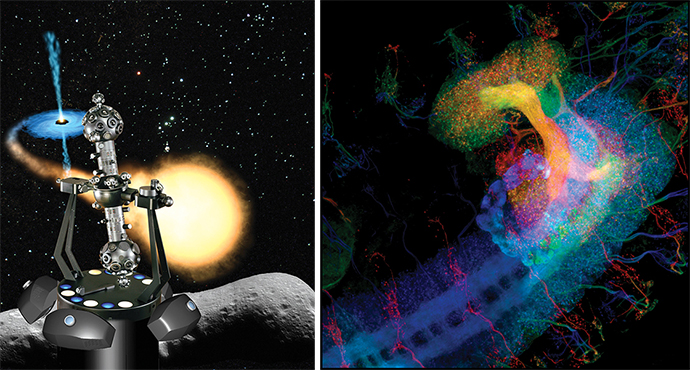
The European Commission’s Regional Innovation Scoreboard found Thuringia to be an “innovation leader” in 2014. Innovation leaders are regions that perform 20 percent or more above the EU average. One of only 10 German federal states with that status, Thuringia has held the honor since 2004, and the optics/photonics cluster is a big reason why.
Hallett, like scientists worldwide, knows the names and heritage well. The discipline of precision optics was created in Jena in the late 1800s by the efforts of three people: Professor Ernst Abbe, Carl Zeiss, and Otto Schott. Their pioneering work is to optics what the work of Steve Jobs and Bill Gates has been to computing.
“It’s a good example for collaboration of industry, research and science,” explains Dr.-Ing. Erik Beckert, group leader, Micro Assembly and System Integration Group, at the Fraunhofer Institute for Applied Optics and Precision Engineering (IOF), one of the leading research institutes for optics and photonics in Europe.
Today Carl Zeiss, Schott and Jenoptik continue to set the high mark in their field. And they provide the sun around which spin-off companies and startups orbit — in keeping with a state that’s home to such a large population of small and medium-sized firms (mittelstand). Other market leaders with presence in Thuringia include JenLab, Asphericon, LEONI Fiber Optics, Jena-Optronik, ifw optronics, Optics Balzers, GÖPEL electronic and piezosystem jena.
Wulff points out that automotive is the state’s leading sector, but optics and photonics may be its leading cluster — precisely because it’s woven like DNA throughout so many sectors. So instead of calling it an industry, “we say it is like a cluster, with strong links, and with a lot of power to promote other industries,” he says. “Some scientists say our century is a century of light.”
Jena and Beyond
Jena has just over 100,000 inhabitants, with nearly about a quarter of them students. That’s to the liking of the talent-hungry optics and photonics companies.
“We have a strong network with the universities and even the schools here, from the beginning,” says Dietmar Ratzsch, president and CEO of Jena-Optronik (an Airbus company), a maker of optical sensors and instruments for space applications. Just as the ocean-traveling explorers of old used the stars for guidance, so do the latest optical guidance instruments on those expensive satellites circling the globe — or on vehicles seeking to dock with the International Space Station, for example. In other words, this is rocket science.
Ratzsch says the universities listen. That’s how his team was able to help develop a new master course in space electronics at the Ernst Abbe University of Applied Sciences Jena. Ratzsch praises the German government’s decision to locate a new institute for smart data in Jena. “This will give us here in Jena a completely new exciting push. We build instruments and sensors now, but we have to provide more information to our customers.”
“The new institute will fit perfectly into the environment and will further strengthen Jena’s scientific community,” said Prof. Dr. Walter Rosenthal, president of the Friedrich Schiller University of Jena, in November 2016 when the new Institute for Smart & Big Data from the German Aerospace Center (DLR) was announced, funded by the Federal Ministry of Economics and Energy (BMWi), as well as co-financing from the Thuringian Ministry of Economics, Science and the Digital Society (TMWWDG).
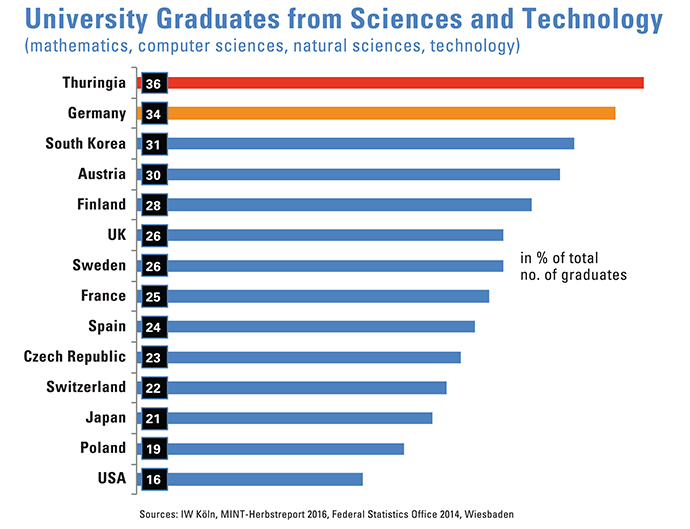
Jena has the highest density of academics in all of Germany, with the lion’s share of the Free State’s 53,000 university students and 30 institutes and a high level of students achieving expertise in MINT courses of study — math, IT, natural sciences and technology. “When you also consider the various Fraunhofer Institutes operating in Thuringia,” says SPIE’s Hallett, “the model seems even better for high-tech in some ways. That sort of institutional money is more patient than a typical venture capitalist, and interested in inventions and manufacturing precision more than consumer applications.”
Thuringia is home to five institutes and research units of the Fraunhofer Gesellschaft, four institutes of the Max Planck Society, one institute of the Helmholtz Association, five institutes and research units of the Leibniz Association and further research institutes. Under the slogan “Life Sciences meets Physics,” the Beutenberg Campus Jena e.V. hosts nine research institutes, two startup centers and small biotech firms on one highly brain-powered plot of land in Jena that’s home to some 2,000 researchers.
“Our biggest goal is to translate fundamental research to application,” says Fraunhofer’s Eric Beckert, noting the organization’s more than 24,000 employees and annual research budget of more than €2 billion, divided by thirds among industry contracts, publicly funded research projects and base funding from the government. “The base funding means a very good technical infrastructure, so we can develop certain technologies that are very close to application. Fraunhofer is in this product development stage when a company is trying to develop something new. That is the basis of our success.”
Asked what makes Fraunhofer such a unique and respected entity worldwide, Erik Beckert could just as easily be speaking about Thuringia as a whole when he says, “The major reason is Fraunhofer is able to adapt to the changing of the world,” even though German authorities are stereotyped as conservative. “We are constantly looking at what the people at universities are developing and how that can be transferred to a real product. Fraunhofer is a living thing with respect to R&D, constantly adapting to what is emerging.”
The difference between this intellectual power and that of some other countries is that students and institutes in Thuringia work directly with companies on innovation. “You have almost all things available here in Jena,” says Jena-Optronik’s Dietmar Ratzsch, not just the universities and specialized institutes, but a network of high-performance, medium-sized specialist firms. As the experience mounts over the years among all the players, the benefit accrues to all.
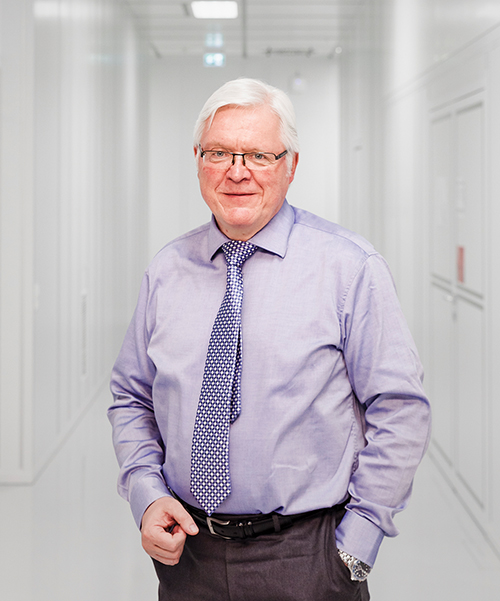
Ratzsch has led Jena-Optronik since 2002 from a €10-million company to €50 million in revenue and 230 employees. The future will include innovation in space, but also in the areas of security, earth observation and weather, environment and traffic control, among others. Space exploration in Europe is a strong market, but he aims to expand optical component partnerships in the US, Israel and Japan.
“For me it’s a passion,” he says of working with aerospace companies and missions. He’s attended two launches, which he admits “sometimes bring tears in your eyes. Anytime you’re part of a strong innovation team, and feel the spirit of the team, you want to do this. Most of the people put 10 years of their lives into bringing this mission to fly.”
Ratzsch counts himself among the fortunate called to lead one of Thuringia’s star performers. A Leipzig native who grew up in the former GDR, he started his career in Jena at Carl Zeiss after studying IT in college. “I come from East Germany, and it was more difficult for me to go to LA or San Francisco than to go to the moon,” he says. Now he goes to those places and others frequently, for conferences and to consult with big-time customers.
“To get this degree of freedom is a gift,” he says, “and I’m personally so grateful to do this, to bring this passion back to our region, tell the story to young people, and tell them, ‘You too can achieve this.’ ”
OptoNet Value
To illustrate the influence of Thuringia in photonics, just do the math.
OptoNet is a cluster organization with more than 100 members headquartered in Jena’s famously cylindrical Intershop tower. OptoNet is a member of OptecNet Deutschland, an association of nine German Competence Networks for Optical Technologies that altogether unite over 450 organizations. So Thuringia, with its cluster representing some 22 percent of OptecNet nationally, more than pulls its weight. Furthermore, the cluster broadcasts its influence via partnerships with such places as Hamamatsu, Japan (initiated by LEG) and Rochester, New York, as well as with the semiconductor industry in neighboring Saxony (via the Silicon Saxony cluster) and in Thuringia itself, where such firms as Fujitsu Technology Solutions and X-Fab operate.
“There would be no integrated circuit without optics,” says Dr. Klaus Schindler, managing director of OptoNet, who started studying physics in Jena in 1971. “It was just the dawn of laser physics at the time. It’s 45 years later now, and it is astonishing what has happened in that time.”
In the days ahead, new avenues to business are opening up, he says, including the field of freeform optics, and IT/software development. While the world of IT and software in Germany is generally thought of as clustered in Berlin (just an hour and a half to the north), the opportunity to create that bridge between software and hardware appears to be the next big opportunity for the region and for the industry at large. Computer programming will play a central role as cluster members pursue work in such areas as man-machine interaction, materials processing and coatings, camera systems, sensors, autonomous vehicles and the world of digitalization and Industry 4.0.

“Satellite navigation is 80 percent software, with big databases,” observes Schindler. “There are all the stars out there, and the satellites are looking at the constellations.”
Cultivating constellations of software and IT startups, among others, should play a huge part in helping corporate investment navigate its way to Thuringia.
Missing Piece May Not Be Far Away
Mike Böttger, vice president of strategy for Jenoptik, agrees that software is the next frontier for his company and for the cluster at large. It only makes sense for a giant firm long known for components and now known for entire systems.
“There is huge potential in my view in opto-electronics, software and image processing, and the better understanding of the core applications,” says Böttger, calling it “the next step” to address the entire world of digitalization. What makes photonics so compelling is “there are so many application fields where we have different technologies, and the combination is what makes it interesting.”
Jenoptik has made its name developing traffic monitoring systems, as well as systems for precision automated manufacturing. Growth markets for its systems include automotive and machine construction; life sciences (the firm is the world leader in lasers for ophthalmology); semiconductors; traffic and aviation; and defense and security.
Like Jena-Optronik’s Dietmar Ratzsch, Böttger is pleased with the dense network of small firms and suppliers in the area. But like any corporate strategy leader, he’s ready to write the next chapter, driven by the twin visions of future innovation and boosting market share.
“Digitalization is really a strong topic to us,” says Böttger. It should be for the region as well, as the opportunity beckons to link the well-known entrepreneur/startup/VC hubs in Leipzig and Berlin with the technology in Jena and environs, and maybe even launch a Thuringia startup scene all its own.
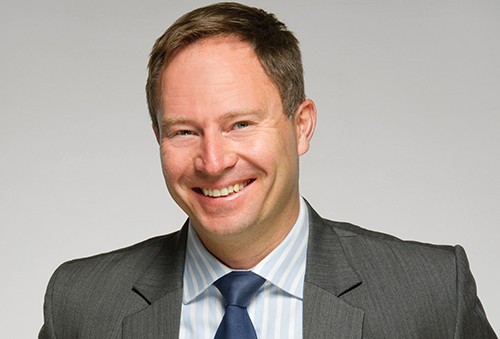
“It has some risks for us as an industry, because there might be some business models where we don’t only [provide] components and systems, but the entire data or entire services for customers,” says Böttger. That’s disruptive, but Böttger is a fan of disruption: “It is interesting to us because of its high potential,” he says of bridging the hardware-software divide. “Now we have to bring them together, and then bring that into the applications.”
Erik Beckert at Fraunhofer sees where this is going too, and can’t wait to get there. Technologies involving lenses with freeform surfaces, night and thermal vision are vital to virtual reality applications as well as a whole class of near-to-eye (N2E) displays such as Google Glass.
“Augmented reality is a great example of how hardware and software need to be integrated, with image creation and transport to drive display, but then the software so as to regulate how to overlay it. It’s a good example showing that optics often needs high computing power.
“I think there has to be a strong interaction between hardware and software,” Beckert continues. “It’s a vision we follow at the IOF — bring computing power closer to the optical component. At the moment, these are two completely different things. If they would come closer, you’d have an embedded computer in your optics, and it would optimize and run the system, that would be a very good benefit. This will be the next step in optics.”
Zeiss Means Leadership
You don’t have to go far from Jenoptik’s headquarters to be at the headquarters of Carl Zeiss Meditec AG, one of four divisions of the Zeiss Group. Founded in Jena in 1846, Zeiss Group — which in 2014-15 had 25,000 employees and revenues of €4.5 billion — now is headquartered in Oberkochen, Germany. But among its 30 production sites and 25 R&D facilities globally, Jena still looms large.
Sebastian Frericks, director of investor relations for Carl Zeiss Meditec AG, says the medical technology division today has just over 400 employees in Jena, and overall accounts for more than a quarter of Zeiss Group revenues. Even as the division grows globally, locations in Jena and Berlin steadily add jobs too, thanks to innovative diagnostic products and laser technology used for procedures related to age-related eye diseases, which, with increased life expectancy, are naturally rising as well.
“We are typically the market leader in most of these technologies today,” says Frericks, and rapidly embracing digitalization.
Among the equipment and diagnostics Zeiss produces are solutions for cataract surgery. It also makes highly sophisticated solutions for refractive correction, the surgery that essentially reshapes the cornea instead of the eyeglass lens. The standard is Lasik, but, Frericks says Zeiss’s safer approach, called Smile, came out of the very building in which he works, and is now produced at a separate location near Jena’s city center, with a price tag of around €400,000. “We are a strong company growing in that vision correction market,” he says. “We just got US approval for this technology, and now are in preparation for market launch,” as the highly competitive arenas of diagnostics and elective surgeries heat up globally. “All of this would not be possible without the technologies based here.”
In terms of big data, Frericks says a lot of thought is going into the marrying of diagnostics and massive patient data, taking very careful steps because of privacy laws. “We have this huge installed database of equipment and devices,” he says. “That could be an asset in itself,” someday taking the form of an app.
Like his counterparts at other companies, Frericks sees a latent bloom for startups and entrepreneurs on the horizon. “We could use more IT and software people,” he says. An acquisition years ago ultimately directed operations to Munich because of easier access to software engineers, but “I see a lot more IT companies here now,” he says. “There’s no lack of talent, and the startup mentality is high.”
Thread of the Future
Eric Lindner, CEO of fiber-embedded sensor company FBGS, is one of those entrepreneurs with a spark in his eye. He was finishing up his PhD at the Leibniz Institute of Photonic Technology (IPHT) in Jena (home to 350 researchers), but wanted to do more than research. He joined FBGS as a project engineer five years ago, and now finds himself leading the whole group, with 17 people working at operations in Jena and in Belgium.
“It’s what I pushed for the last five years, and now I’d like to see the commercial success,” he says. “It’s my baby.” The technology — targeted for catheters and other high-end tools, is not yet a commodity product, but it’s getting there fast thanks to the Thuringian connection. Today the fledgling company is working with 500 customers in 36 countries, and aims to move from fore-sensing to shape sensing eventually, which may be of interest to the oil & gas sector.
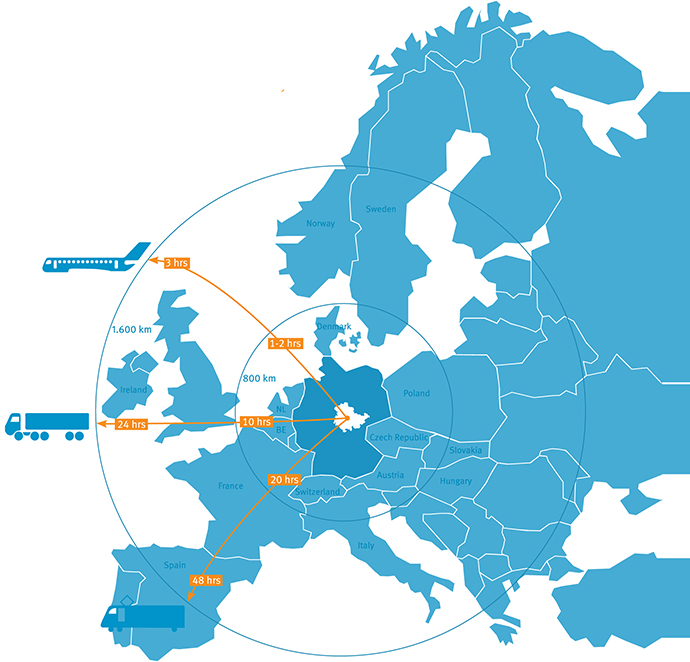
Meanwhile, the firm continues to do a lot of research with IPHT, as well as actual production. Being embedded in the Beutenberg campus research environment only helps, he says, in part because of the sense of community among the institutes.
Intellectual property is shared on government-funded projects, and since universities are not allowed to pursue commercial activity, it’s mostly taken up by the company, Lindner explains. Getting from prototype to founding a company can be harder, says Lindner, “but there is so much potential,” he says, “even here in just this area.”
At 34 years old, Lindner is about half the age of Jena-Optronik’s Dietmar Ratzsch, but with one thing in common: an East German past. So, like Ratzsch, he clearly sees the past, appreciates the present and is optimistic about the future.
“My parents grew up with a lot of limitations, when you were not allowed to fund companies,” he says. “If you’re watched for 30 years, every step you take, that’s what limited entrepreneurship in the eastern part of Germany. And there has been a lot of hesitation the past 10-15 years for founding companies.” All it’s taken is a change in mindset, “but it’s coming now in my generation and the younger generation. There is no fear anymore — that is gone.”
This Investment Profile was prepared under the auspices of LEG Thuringen – the State Development Corporation of Thuringia. For more information, call +49 361 5603-450, email invest@leg-thueringen.de or visit www.invest-in-thuringia.de.
